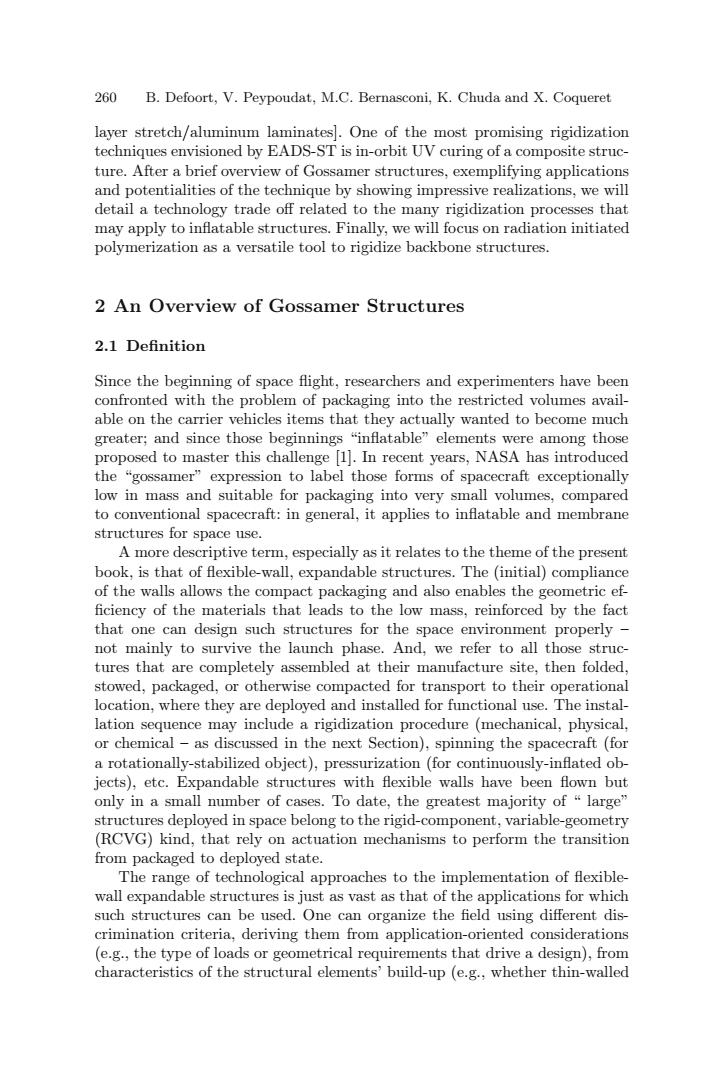正在加载图片...

260 B.Defoort,V.Peypoudat,M.C.Bernasconi,K.Chuda and X.Coqueret layer stretch/aluminum laminates.One of the most promising rigidization techniques envisioned by EADS-ST is in-orbit UV curing of a composite struc- ture.After a brief overview of Gossamer structures,exemplifying applications and potentialities of the technique by showing impressive realizations,we will detail a technology trade off related to the many rigidization processes that may apply to inflatable structures.Finally,we will focus on radiation initiated polymerization as a versatile tool to rigidize backbone structures. 2 An Overview of Gossamer Structures 2.1 Definition Since the beginning of space flight,researchers and experimenters have been confronted with the problem of packaging into the restricted volumes avail- able on the carrier vehicles items that they actually wanted to become much greater;and since those beginnings "inflatable"elements were among those proposed to master this challenge [1].In recent years,NASA has introduced the "gossamer"expression to label those forms of spacecraft exceptionally low in mass and suitable for packaging into very small volumes,compared to conventional spacecraft:in general,it applies to inflatable and membrane structures for space use. A more descriptive term,especially as it relates to the theme of the present book,is that of flexible-wall,expandable structures.The (initial)compliance of the walls allows the compact packaging and also enables the geometric ef ficiency of the materials that leads to the low mass,reinforced by the fact that one can design such structures for the space environment properly not mainly to survive the launch phase.And,we refer to all those struc- tures that are completely assembled at their manufacture site,then folded, stowed,packaged,or otherwise compacted for transport to their operational location,where they are deployed and installed for functional use.The instal- lation sequence may include a rigidization procedure(mechanical,physical, or chemical-as discussed in the next Section),spinning the spacecraft (for a rotationally-stabilized object),pressurization (for continuously-inflated ob- jects),etc.Expandable structures with flexible walls have been flown but only in a small number of cases.To date,the greatest majority of "large" structures deployed in space belong to the rigid-component,variable-geometry (RCVG)kind,that rely on actuation mechanisms to perform the transition from packaged to deployed state. The range of technological approaches to the implementation of flexible- wall expandable structures is just as vast as that of the applications for which such structures can be used.One can organize the field using different dis- crimination criteria,deriving them from application-oriented considerations (e.g.,the type of loads or geometrical requirements that drive a design),from characteristics of the structural elements'build-up (e.g.,whether thin-walled260 B. Defoort, V. Peypoudat, M.C. Bernasconi, K. Chuda and X. Coqueret layer stretch/aluminum laminates]. One of the most promising rigidization techniques envisioned by EADS-ST is in-orbit UV curing of a composite structure. After a brief overview of Gossamer structures, exemplifying applications and potentialities of the technique by showing impressive realizations, we will detail a technology trade off related to the many rigidization processes that may apply to inflatable structures. Finally, we will focus on radiation initiated polymerization as a versatile tool to rigidize backbone structures. 2 An Overview of Gossamer Structures 2.1 Definition Since the beginning of space flight, researchers and experimenters have been confronted with the problem of packaging into the restricted volumes available on the carrier vehicles items that they actually wanted to become much greater; and since those beginnings “inflatable” elements were among those proposed to master this challenge [1]. In recent years, NASA has introduced the “gossamer” expression to label those forms of spacecraft exceptionally low in mass and suitable for packaging into very small volumes, compared to conventional spacecraft: in general, it applies to inflatable and membrane structures for space use. A more descriptive term, especially as it relates to the theme of the present book, is that of flexible-wall, expandable structures. The (initial) compliance of the walls allows the compact packaging and also enables the geometric ef- ficiency of the materials that leads to the low mass, reinforced by the fact that one can design such structures for the space environment properly – not mainly to survive the launch phase. And, we refer to all those structures that are completely assembled at their manufacture site, then folded, stowed, packaged, or otherwise compacted for transport to their operational location, where they are deployed and installed for functional use. The installation sequence may include a rigidization procedure (mechanical, physical, or chemical – as discussed in the next Section), spinning the spacecraft (for a rotationally-stabilized object), pressurization (for continuously-inflated objects), etc. Expandable structures with flexible walls have been flown but only in a small number of cases. To date, the greatest majority of “ large” structures deployed in space belong to the rigid-component, variable-geometry (RCVG) kind, that rely on actuation mechanisms to perform the transition from packaged to deployed state. The range of technological approaches to the implementation of flexiblewall expandable structures is just as vast as that of the applications for which such structures can be used. One can organize the field using different discrimination criteria, deriving them from application-oriented considerations (e.g., the type of loads or geometrical requirements that drive a design), from characteristics of the structural elements’ build-up (e.g., whether thin-walled